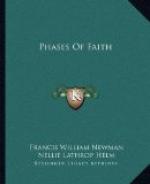I had also discerned in the opening of Genesis things which could not be literally received. The geography of the rivers in Paradise is inexplicable, though it assumes the tone of explanation. The curse on the serpent, who is to go on his belly—(how else did he go before?)—and eat dust, is a capricious punishment on a race of brutes, one of whom the Devil chose to use as his instrument. That the painfulness of childbirth is caused, not by Eve’s sin, but by artificial habits and a weakened nervous system, seems to be proved by the twofold fact, that savage women and wild animals suffer but little, and tame cattle often suffer as much as human females.—About this time also, I had perceived (what I afterwards learned the Germans to have more fully investigated) that the two different accounts of the Creation are distinguished by the appellations given to the divine Creator. I did not see how to resist the inference that the book is made up of heterogeneous documents, and was not put forth by the direct dictation of the Spirit to Moses.
A new stimulus was after this given to my mind by two short conversations with the late excellent Dr. Arnold at Rugby. I had become aware of the difficulties encountered by physiologists in believing the whole human race to have proceeded in about 6000 years from a single Adam and Eve; and that the longevity (not miraculous, but ordinary) attributed to the patriarchs was another stumbling-block. The geological difficulties of the Mosaic cosmogony were also at that time exciting attention. It was a novelty to me, that Arnold treated these questions as matters of indifference to religion; and did not hesitate to say, that the account of Noah’s deluge was evidently mythical, and the history of Joseph “a beautiful poem.” I was staggered at this. If all were not descended




